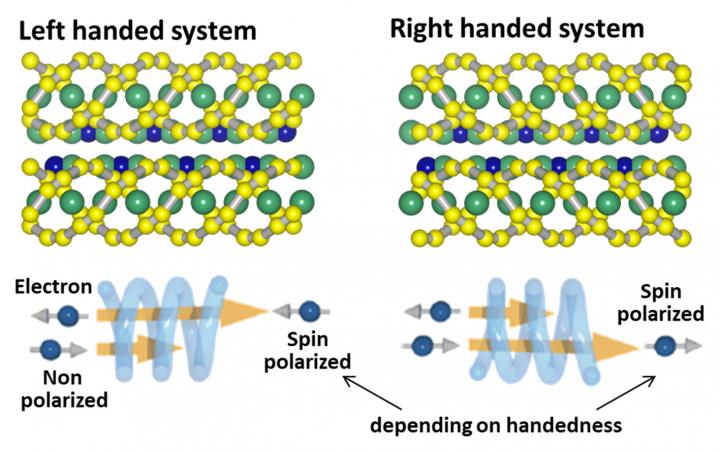Chiral crystals blowing off polarized spins: Phenomena detected without magnets

Schematics of crystalline structures of chiral crystals CrNb3S6 and spin-polarization phenomena in chiral materials. A tiny helical structure at atomic scale generates spin-polarized current (electron flow). Credit: NINS/IMS
The structure of a material which consists of atoms and/or molecules may exhibit chirality. It is known that chiral molecules or chiral crystals show a chiral structure, as exemplified by deoxyribonucleic acid (DNA), amino acids, and sugars.
Such chiral substances are inevitable in living activity. However, their electrical and magnetic characteristics have attracted little attention so far.
Recently, it was found by Ron Naaman et al. in Israel that electron spins orient in the same direction when electrons pass through chiral molecules such as DNA.
Because the direction of spins depends on the handedness of a chiral molecule structure, this phenomenon is called chirality-induced spin selectivity (CISS).
CISS research clarified that non-magnetic chiral molecules make electrons spin polarized. This phenomenon is very puzzling and its mechanism remains to be clarified.
To produce a spin-polarized state in a non-magnetic material is an important research target to promote the next generation electronics and quantum science. It is very interesting to investigate how universal the spin-polarized phenomena are in chiral materials widely found in molecules and crystals.
In this study, the researchers at Osaka Prefecture University, Institute for Molecular Science, The Open University of Japan, and Toho University focused not a chiral molecule but a 'chiral crystal'. The chiral crystal that the researchers have investigated possesses a helical arrangement of atoms twisting in one direction.
Such a helical structure appears all over the chiral crystal, as shown in upper panel of Figure. Although molecules are very tiny invisible entities, crystals are large enough to be handled. The crystals also exhibit fabrication feasibility and material stability in usual cases.
A chiral crystal CrNb3S6 used in this study is a metal that conducts electricity well but exhibits no magnetism at room temperature in the absence of magnetic field. However, the experiments clarified that electrons flowing in CrNb3S6 are spin polarized. Namely, the chiral crystal plays a role to make the spins of flowing electrons aligned in the same direction spontaneously.
Applying an electrical current into the coil found in our daily life induces magnetic fields in the coil. This is a macroscopic electromagnet generating macroscopic magnetic fields. A helical atomic configuration found in the crystals plays a role to generate polarized spins. Namely, it behaves as a 'microscopic' electromagnet generating polarized spin in the microscopic tiny world.
This study clarified that spin-polarized phenomena initially found in chiral molecules occur even in chiral solid crystals, suggesting that such phenomena appear universally in a wide range of chiral materials from chiral molecules to chiral crystals. The study made a fundamental and significant contribution to the research field of spin manipulation and detection in combination with chiral systems.
###
Research Contacts:
Prof. Yoshihiko TOGAWA, Osaka Prefecture University
E-mail: y-togawa_at_pe.osakafu-u.ac.jp
Prof. Hiroshi M. YAMAMOTO, Institute for Molecular Science
E-mail: yhiroshi_at_ims.ac.jp
Prof. Jun-ichiro KISHINE, The Open University of Japan
E-mail: kishine_at_ouj.ac.jp
Prof. Jun-ichiro OHE, Toho University
E-mail: junichirou.ohe_at_sci.toho-u.ac.jp
Media Contact
More Information:
http://dx.doi.org/10.1103/PhysRevLett.124.166602All latest news from the category: Life Sciences and Chemistry
Articles and reports from the Life Sciences and chemistry area deal with applied and basic research into modern biology, chemistry and human medicine.
Valuable information can be found on a range of life sciences fields including bacteriology, biochemistry, bionics, bioinformatics, biophysics, biotechnology, genetics, geobotany, human biology, marine biology, microbiology, molecular biology, cellular biology, zoology, bioinorganic chemistry, microchemistry and environmental chemistry.
Newest articles

Sea slugs inspire highly stretchable biomedical sensor
USC Viterbi School of Engineering researcher Hangbo Zhao presents findings on highly stretchable and customizable microneedles for application in fields including neuroscience, tissue engineering, and wearable bioelectronics. The revolution in…

Twisting and binding matter waves with photons in a cavity
Precisely measuring the energy states of individual atoms has been a historical challenge for physicists due to atomic recoil. When an atom interacts with a photon, the atom “recoils” in…

Nanotubes, nanoparticles, and antibodies detect tiny amounts of fentanyl
New sensor is six orders of magnitude more sensitive than the next best thing. A research team at Pitt led by Alexander Star, a chemistry professor in the Kenneth P. Dietrich…





















